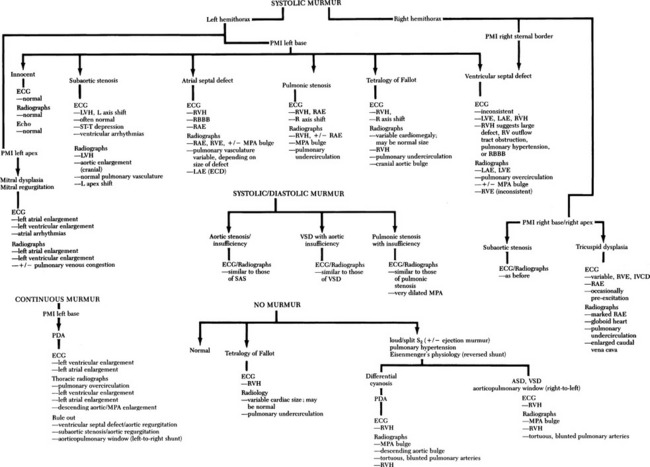Chapter 154 Congenital Heart Disease
ETIOLOGY
CLINICAL APPROACH
The vast majority of CHD cases are recognized initially by cardiac auscultation. A routine 6-lead electrocardiogram (ECG) and thoracic radiographs will also provide diagnostic information in cases of moderate to severe CHD; however, these studies are likely to be negative in mild disease. Definitive diagnosis requires advanced echocardiography with Doppler studies. The general approach to diagnosis based on initial auscultation findings is summarized in Figure 154-1 along with typical ECG and radiographic features. The following are some pointers regarding diagnosis and assessment of CHD in dogs and cats.
DIAGNOSIS
Despite the technical advances in cardiology, a thorough history and physical examination is an essential part of the diagnostic process. In the evaluation of CHD, cardiac auscultation is especially important (Fig. 154-1), and experienced examiners can often establish a tentative diagnosis based on auscultation and breed predisposition (Table 154-1).
Table 154-1 BREED AND SEX PREDILECTIONS FOR CERTAIN CONGENITAL CARDIAC DEFECTS*
| Defect | Predilection |
|---|---|
| Patent ductus arteriosus (PDA) | Poodle, Bichon friese, collie, Pomeranian, German shepherd, Shetland sheepdog, and many other breeds (female:male, 2.2:1) |
| Pulmonic stenosis (PS) | Beagle, bulldog, fox terrier, miniature schnauzer, Chihuahua, Samoyed, Labrador retriever |
| Subaortic stenosis (SAS) | Newfoundland, boxer, German shepherd, German shorthaired pointer, golden retriever, rottweiler, bull terrier |
| Ventricular septal defect (VSD) | English bulldog, springer spaniel |
| Atrial septal defect (ASD) | Samoyed, boxer, Doberman pinscher |
| Mitral dysplasia | Great Dane, German shepherd, bull terrier (male > female) |
| Tricuspid dysplasia | Great Dane, German shepherd, Weimaraner, Labrador retriever (male > female) |
| Tetralogy of Fallot | Keeshond, English bulldog |
* Note: SAS, PDA, and PS are the most common defects in dogs. ASD/VSD and atrioventricular valve dysplasias are the most common defects in cats.
Signalment and History
Age, breed, and sex should be considered when evaluating animals for suspected CHD. As many specific breed predilections are identified—especially in dogs—a predisposition can be useful in formulating the differential diagnoses. Table 154-1 is a guide to breed for the most commonly recognized disorders, but is not a comprehensive listing.
Physical Examination
Precordial Palpation
Cardiac Murmurs
Stay updated, free articles. Join our Telegram channel

Full access? Get Clinical Tree



